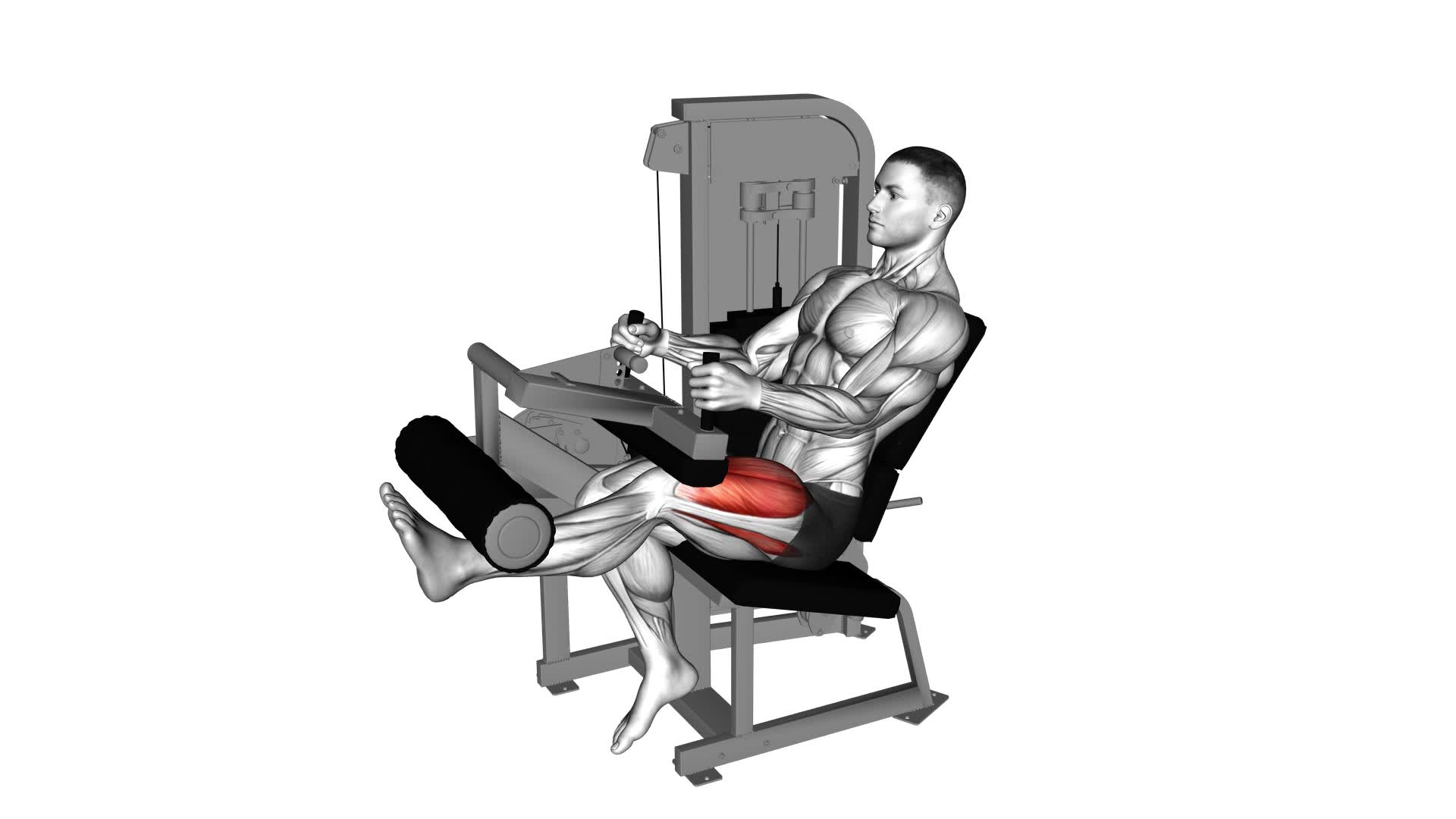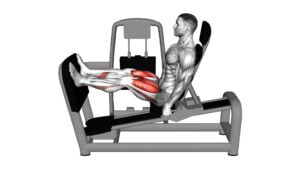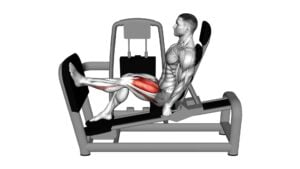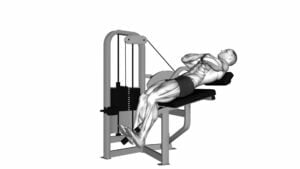Lever Seated Leg Extension (VERSION 2) – Video Exercise Guide & Tips

Are you looking to strengthen your legs and improve your lower body strength? Look no further than the Lever Seated Leg Extension (Version 2).
Watch This Exercise Video
This exercise targets your quadriceps and helps to build muscle and increase power in your legs. In this video exercise guide, we will show you the proper form and technique for performing this exercise, as well as common mistakes to avoid and tips to maximize its effectiveness.
Get ready to take your leg workout to the next level!
Key Takeaways
- Increased quadriceps strength and muscle definition
- Targets quadriceps muscles for maximum activation
- Provides joint stability benefits
- Reduces stress on the knees
Benefits of Lever Seated Leg Extension (Version 2)
The lever seated leg extension (Version 2) offers increased quadriceps strength and muscle definition. This exercise targets the quadriceps muscles, activating them throughout the entire range of motion for maximum muscle activation. It is especially beneficial for developing strong and well-defined quadriceps.
In addition to muscle activation, the lever seated leg extension (Version 2) provides joint stability benefits. By supporting the knees, the machine reduces stress on the joint and minimizes the risk of injury. This is especially important for individuals with knee issues or those recovering from knee injuries.
Proper form and technique are crucial for maximizing the benefits of the lever seated leg extension (Version 2). Maintaining a stable seated position with a flat back against the pad ensures proper alignment and minimizes strain on the lower back. Starting with a weight that allows for controlled and proper movement is important. Remember to breathe throughout the exercise and avoid locking the knees at the top of the movement.
Transitioning into the subsequent section about proper form and technique for the lever seated leg extension (Version 2), understanding the correct execution is essential to prevent injuries and maximize the benefits of this exercise.
Proper Form and Technique for Lever Seated Leg Extension (Version 2)
To properly perform the lever seated leg extension (Version 2), you should focus on maintaining a stable seated position and engaging your quadriceps muscles throughout the entire range of motion. Start by adjusting the seat height so that your knees are in line with the axis of rotation. Sit with your back against the backrest and grab the side handles for support. Place your shins against the padded bar, just above your ankles. Keep your core engaged and your feet flat on the footrest.
To initiate the movement, exhale and extend your legs in a controlled manner, pushing the padded bar away from your body until your legs are almost fully extended. Avoid locking your knees at the top of the movement to prevent unnecessary stress on the joint. Pause briefly, then inhale and slowly return to the starting position, maintaining tension in your quadriceps throughout the exercise.
This exercise primarily targets the quadriceps muscles, including the rectus femoris, vastus lateralis, vastus medialis, and vastus intermedius. It's an effective way to isolate and strengthen these muscles.
However, if you're looking for alternative exercises that target the same muscle group, you can consider exercises like squats, lunges, and leg presses. These exercises also engage the glutes and hamstrings to a greater extent, providing a more comprehensive lower body workout.
Remember to always consult with a fitness professional or trainer to ensure proper form and technique when performing any exercise.
Common Mistakes to Avoid During Lever Seated Leg Extension (Version 2)
Avoid these common mistakes when performing the lever seated leg extension (Version 2) to ensure proper form and maximize the effectiveness of the exercise.
One common mistake to avoid is using too much weight. While it may be tempting to increase the weight to challenge yourself, using excessive weight can lead to improper form and strain on your muscles. It's important to find a weight that allows you to perform the exercise with controlled movements and without compromising your form.
Another common mistake is neglecting muscle imbalances. The lever seated leg extension primarily targets the quadriceps muscles, but it's important to also strengthen the opposing muscle group, the hamstrings. Ignoring the hamstrings can lead to muscle imbalances and increase the risk of injury. To address this, incorporate exercises that target the hamstrings into your workout routine, such as hamstring curls or deadlifts.
Additionally, avoid using momentum to complete the exercise. Using momentum instead of relying on your muscles can reduce the effectiveness of the exercise and increase the risk of injury. Focus on controlled movements and maintain a slow and steady pace throughout the entire range of motion.
Tips to Maximize the Effectiveness of Lever Seated Leg Extension (Version 2)
To get the most out of your lever seated leg extension (Version 2), focus on proper technique and engage your quadriceps with each repetition. Improving stability and maximizing muscle activation are key to enhancing the effectiveness of this exercise.
First and foremost, ensure that your seat and backrest are properly adjusted to maintain a stable position throughout the movement. This will help prevent unnecessary strain on your lower back and allow you to fully engage your quadriceps.
Next, pay attention to your foot placement. Keep your feet flat on the footplate, with your toes pointing forward. This will help target your quadriceps more effectively and minimize the involvement of other muscles.
As you perform the exercise, concentrate on using your quadriceps to extend your legs fully. Avoid using momentum or relying on other muscles to complete the movement. Focus on a slow and controlled motion, emphasizing the contraction of your quadriceps at the top of the movement.
Lastly, make sure to breathe properly throughout the exercise. Exhale as you extend your legs and inhale as you return back to the starting position. This will help maintain stability and support proper muscle activation.
Variations and Progressions for Lever Seated Leg Extension (Version 2)
To progress the lever seated leg extension (Version 2), try incorporating variations that target different aspects of your quadriceps muscles.
By adding variations to your leg extension exercise, you can challenge your muscles in new ways and prevent plateaus in your progress.
One variation you can try is the single-leg lever seated leg extension. This variation isolates each leg individually, allowing for a greater focus on each quadriceps muscle.
Another option is to increase the weight or resistance used during the exercise. This progression can help build strength and muscle size in your quadriceps.
Additionally, you can try slowing down the movement, focusing on the eccentric or lowering phase of the exercise. This can increase time under tension and further engage your quadriceps muscles.
Finally, you can incorporate isometric holds at the top of the movement. By pausing and holding the contraction for a few seconds, you can further challenge your quadriceps muscles.
Remember to always use proper form and start with a weight or resistance level that's suitable for your fitness level. As you become more comfortable and stronger, gradually increase the difficulty of the variations and progressions.
Frequently Asked Questions
How Many Sets and Reps Should I Perform for the Lever Seated Leg Extension (Version 2)?
For the lever seated leg extension (version 2), the optimal rep range varies based on your goals. Generally, aim for 3-4 sets of 8-12 reps to build strength and muscle.
However, if you want to focus on endurance, you can do higher reps in the range of 15-20.
Additionally, there are variations of this exercise that target different leg muscles, such as the single-leg version for greater balance and stability.
Can I Perform the Lever Seated Leg Extension (Version 2) With an Injury or Pre-Existing Condition?
If you have an injury or pre-existing condition, it's important to take precautions when performing the lever seated leg extension (version 2).
Make sure to consult with a medical professional or a certified trainer before attempting this exercise. They can provide you with modifications or alternative exercises that are better suited for your condition.
Your safety and well-being should always be the top priority when it comes to exercising with an injury.
Is It Necessary to Use a Specific Weight or Resistance for the Lever Seated Leg Extension (Version 2)?
When performing the lever seated leg extension (version 2), it's important to consider the resistance options that are available to you.
The specific weight or resistance will vary depending on your fitness level and goals. It's recommended to start with a weight or resistance that challenges you but still allows you to maintain proper form and technique.
As you progress, you can gradually increase the weight or resistance to continue challenging your muscles.
There are also variations of the lever seated leg extension (version 2) exercises that can target different muscle groups for added variety and benefits.
Can I Substitute the Lever Seated Leg Extension (Version 2) With Other Exercises for Similar Results?
Yes, you can substitute the lever seated leg extension (version 2) with other exercises for similar results.
There are alternatives to this exercise that can target your leg muscles effectively, such as squats, lunges, or leg presses.
However, it's important to note that the lever seated leg extension offers specific benefits, like isolating and strengthening your quadriceps.
How Long Should I Rest Between Sets of the Lever Seated Leg Extension (Version 2)?
To get the best results from the lever seated leg extension (version 2), it's important to know how long to rest between sets. Rest duration will depend on your fitness level and goals.
However, it's generally recommended to rest for about 1-2 minutes between sets to allow your muscles time to recover. This will help maintain proper form and prevent fatigue, ensuring you get the most out of each set.
Conclusion
In conclusion, lever seated leg extension (version 2) is a highly effective exercise for targeting and strengthening the muscles in your legs. By following proper form and technique, avoiding common mistakes, and implementing tips to maximize effectiveness, you can achieve optimal results.
Additionally, there are variations and progressions available to challenge yourself and continue progressing in your fitness journey. Incorporate this exercise into your routine to improve leg strength and overall lower body fitness.

Author
Years ago, the spark of my life’s passion ignited in my mind the moment I stepped into the local gym for the first time. The inaugural bead of perspiration, the initial endeavor, the very first surge of endorphins, and a sense of pride that washed over me post-workout marked the beginning of my deep-seated interest in strength sports, fitness, and sports nutrition. This very curiosity blossomed rapidly into a profound fascination, propelling me to earn a Master’s degree in Physical Education from the Academy of Physical Education in Krakow, followed by a Sports Manager diploma from the Jagiellonian University. My journey of growth led me to gain more specialized qualifications, such as being a certified personal trainer with a focus on sports dietetics, a lifeguard, and an instructor for wellness and corrective gymnastics. Theoretical knowledge paired seamlessly with practical experience, reinforcing my belief that the transformation of individuals under my guidance was also a reflection of my personal growth. This belief holds true even today. Each day, I strive to push the boundaries and explore new realms. These realms gently elevate me to greater heights. The unique combination of passion for my field and the continuous quest for growth fuels my drive to break new ground.







